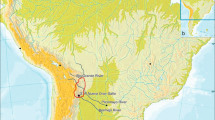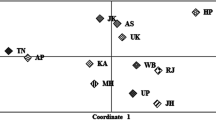Abstract
In this study, the Kashmiri population was genetically screened for fifteen autosomal STRs, seventeen Y-chromosomal STRs and mitochondrial DNA control region SNPs. Autosomal STRs exhibited that D2S1338 was the most discriminatory locus with value of 0.963 whereas combine power of discrimination was 0.999999999999999. On the other hand, analysis of Y-chromosomal STRs generated 59 distinct haplotypes of which 52 were unique with haplotype diversity value of 0.99752. Mitochondrial D-loop analysis resulted that haplogroups M and U were found most prevalent with 25% each. Haplotypic data of Y-STRs was submitted to YHRD under accession number YA004153 whereas mitochondrial DNA control region (CR) sequences were submitted to EMPOP with accession number EMP00683.
Similar content being viewed by others
References
Kivisild T, Bamshad MJ, Kaldma K, Metspalu M, Metspalu E, Reidla M, Laos S, Parik J, Watkins WS, Dixon ME (1999) Deep common ancestry of Indian and western-Eurasian mitochondrial DNA lineages. Curr Biol 9(22):1331–1334
Katz N (1991) Contacts between Jewish and Indotibetan civilizations through the ages: some explorations. Tibet J 16(4):90–109
Bhoi T Archaeological references of ancient Greeks in Kashmir region
Allgood M (2009) What da Vinci really didn’t want you to know: the Jesus conspiracy. AuthorHouse
Bar W, Brinkmann B, Budowle B, Carracedo A, Gill P, Lincoln P, Mayr W, Olaisen B (1997) DNA recommendations further report of the DNA commission of the ISFH regarding the use of short tandem repeat systems. Int J Legal Med 110(4):175–176
Rozen S, Skaletsky H (1999) Primer3 on the www for general users and for biologist programmers. Bioinform Methods Protocols. pp 365–386
Yang IS, Lee HY, Yang WI, Shin KJ (2013) mtDNAprofiler: a web application for the nomenclature and comparison of human mitochondrial DNA sequences. J Forensic Sci 58(4):972–980
Kloss-Brandstätter A, Pacher D, Schönherr S, Weissensteiner H, Binna R, Specht G, Kronenberg F (2011) HaploGrep: a fast and reliable algorithm for automatic classification of mitochondrial DNA haplogroups. Hum Mutat 32(1):25–32
Parson W, Dür A (2007) Empop—a forensic mtdna database. Forensic Sci Int Genet 1(2):88–92
Tereba A (1999) Tools for analysis of population statistics. Profiles in DNA. 3
Liu K, Muse SV (2005) Powermarker: an integrated analysis environment for genetic marker analysis. Bioinformatics 21(9):2128–2129
Excoffier L, Laval G, Schneider S (2005) Arlequin (version 3.0): an integrated software package for population genetics data analysis. Evol Bioinformatics Online 1:47
Nei M (1987) Molecular evolutionary genetics. Columbia university press
Parson W, Roewer L (2010) Publication of population data of linearly inherited DNA markers in the International Journal of Legal Medicine. Int J Legal Med 124:505–509
Poetsch M, Bajanowski T, Pfeiffer H (2012) The publication of population genetic data in the International Journal of Legal Medicine: guidelines. Int J Legal Med 126:489–490
Author information
Authors and Affiliations
Corresponding author
Ethics declarations
Conflict of interest
The authors declare that they have no conflict of interest.
Additional information
Publisher’s note
Springer Nature remains neutral with regard to jurisdictional claims in published maps and institutional affiliations.
Rights and permissions
About this article
Cite this article
Perveen, R., Shahid, A.A., Shafique, M. et al. Kashmiris phylogenetic depictions through uniparental and biparental genetic markers. Int J Legal Med 134, 1311–1312 (2020). https://doi.org/10.1007/s00414-019-02082-5
Received:
Accepted:
Published:
Issue Date:
DOI: https://doi.org/10.1007/s00414-019-02082-5




